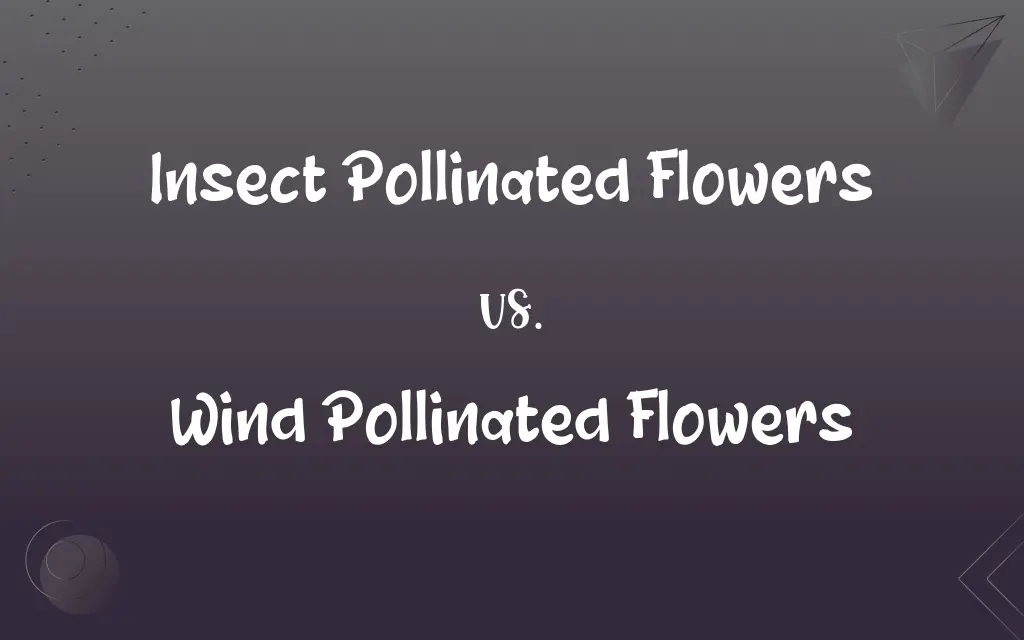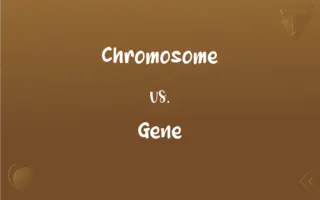Insect Pollinated Flowers vs. Wind Pollinated Flowers: What's the Difference?
Edited by Aimie Carlson || By Janet White || Published on February 18, 2024
Insect-pollinated flowers are colorful and fragrant to attract insects, whereas wind-pollinated flowers are simpler and rely on wind for pollen transfer.

Key Differences
Insect-pollinated flowers typically have bright colors and sweet fragrances to attract insects, while wind-pollinated flowers often lack these features, as they do not need to attract pollinators.
The pollen of insect-pollinated flowers is usually sticky or spiky to adhere to insects, contrasting with the lighter, smoother pollen of wind-pollinated flowers designed for airborne dispersal.
Insect-pollinated flowers generally have petals arranged to provide easy access for insects, whereas wind-pollinated flowers may have reduced or absent petals, as they do not rely on insects for pollination.
Insect-pollinated flowers often produce nectar and larger quantities of pollen to feed their pollinators, while wind-pollinated flowers typically do not produce nectar and may produce more pollen to increase the likelihood of wind dispersal.
Insect-pollinated flowers may have specific blooming periods to coincide with the activity of their insect pollinators, while wind-pollinated flowers often rely on favorable wind conditions, leading to different blooming strategies.
ADVERTISEMENT
Comparison Chart
Appearance
Colorful and fragrant
Typically dull and not fragrant
Pollen Characteristics
Sticky or spiky for adherence to insects
Light and smooth for wind dispersal
Petal Arrangement
Petals arranged for easy insect access
Reduced or absent petals
Nectar and Pollen Production
Produce nectar, more pollen
Do not produce nectar, produce abundant pollen
Blooming Period
Specific periods matching insect activity
Often based on favorable wind conditions
ADVERTISEMENT
Insect Pollinated Flowers and Wind Pollinated Flowers Definitions
Insect Pollinated Flowers
Blooms characterized by bright colors and sweet scents to allure insects.
Lavender, with its appealing fragrance, is an insect-pollinated flower favored by many pollinators.
Wind Pollinated Flowers
Plants producing large amounts of light, airborne pollen optimized for wind dispersal.
The wind-pollinated flowers of pine trees release clouds of pollen into the air.
Insect Pollinated Flowers
Plants that produce nectar and pollen specifically to feed and attract pollinating insects.
The insect-pollinated flower, honeysuckle, produces sweet nectar that attracts hummingbirds and bees.
Wind Pollinated Flowers
Blooms with reduced or no petals, not requiring visual or scent allure for pollination.
Oak trees have wind-pollinated flowers, lacking the showy petals of insect-pollinated species.
Insect Pollinated Flowers
Floral species where insects play a crucial role in the reproductive process.
The apple tree's blossoms are insect-pollinated flowers, essential for fruit production.
Wind Pollinated Flowers
Flowers that rely on wind currents to transfer pollen from one flower to another.
Grasses often have wind-pollinated flowers, which explains why they cause seasonal allergies.
Insect Pollinated Flowers
Flowers that depend on insects for transferring pollen from one flower to another.
The rose is a classic example of an insect-pollinated flower, attracting bees with its vibrant colors.
Wind Pollinated Flowers
Species where flowers are typically dull and inconspicuous, as they do not attract pollinators.
Wheat fields consist of wind-pollinated flowers, unremarkable in appearance.
Insect Pollinated Flowers
Flowers designed to facilitate insect access for efficient pollination.
Sunflowers, with their large heads, are insect-pollinated flowers that provide a landing platform for bees.
Wind Pollinated Flowers
Floral types that depend on wind rather than biotic agents for pollination.
The wind-pollinated flowers of corn are crucial for the crop's successful growth and seed formation.
FAQs
Do wind-pollinated flowers produce nectar?
No, they usually do not produce nectar.
What kind of pollen do insect-pollinated flowers produce?
Sticky or spiky pollen to adhere to insects.
What are wind-pollinated flowers?
Flowers that depend on wind to carry pollen from one flower to another.
How do insect-pollinated flowers attract insects?
They have bright colors and fragrances to lure insects.
What are insect-pollinated flowers?
Flowers that rely on insects for transferring pollen between flowers.
How do wind-pollinated flowers appear?
They are typically duller and less conspicuous.
What is the pollen like in wind-pollinated flowers?
Light and smooth, ideal for wind dispersal.
What is the ecological significance of wind-pollinated flowers?
They contribute to the reproduction of many grasses and trees.
Are insect-pollinated flowers usually colorful?
Yes, they are often brightly colored.
Do wind-pollinated flowers have prominent petals?
No, they often have reduced or no petals.
How does weather affect insect-pollinated flowers?
Bad weather can reduce insect activity, affecting pollination.
What role do petals play in insect-pollinated flowers?
Petals are arranged to facilitate insect access.
Are wind-pollinated flowers affected by weather?
Yes, wind speed and direction can influence their pollination success.
Why are insect-pollinated flowers important?
They are crucial for biodiversity and ecosystem health.
Are insect-pollinated flowers found in all environments?
They are widespread but more common in areas with diverse insect life.
What influences the blooming of wind-pollinated flowers?
They often bloom based on favorable wind conditions.
Can a plant have both insect-pollinated and wind-pollinated flowers?
Yes, some plants have both types of flowers.
What environments favor wind-pollinated flowers?
Areas where wind dispersal is efficient, like open fields and forests.
What is the human impact on insect-pollinated flowers?
Activities like habitat destruction and pesticide use can negatively impact them.
When do insect-pollinated flowers usually bloom?
During periods that coincide with insect activity.
About Author
Written by
Janet WhiteJanet White has been an esteemed writer and blogger for Difference Wiki. Holding a Master's degree in Science and Medical Journalism from the prestigious Boston University, she has consistently demonstrated her expertise and passion for her field. When she's not immersed in her work, Janet relishes her time exercising, delving into a good book, and cherishing moments with friends and family.
Edited by
Aimie CarlsonAimie Carlson, holding a master's degree in English literature, is a fervent English language enthusiast. She lends her writing talents to Difference Wiki, a prominent website that specializes in comparisons, offering readers insightful analyses that both captivate and inform.































































